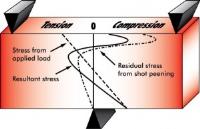 Add My Company
Add My Company
Sign In
How did the Shot Peening Process begin?
13-10-2015

Hammering or cold hammering stresses a material through force beyond its yield strength, so allowing it to be shaped and hardened. The earliest example of this process can be traced back to a gold helmet circa 2700 B.C.
In addition to shaping, cold hammering was also used to strengthen metals and was widely used in producing the final shape and hardness of armour during the crusades (1100-1400 A.D.).
During the 11th Century the sword makers of Toledo produced a sword so superior to any other that they became highly prized and sought after. As well as lightweight, it was very strong and held a sharp edge and could also be bent almost double over and over without breaking. Naturally these blacksmiths would not have known that the hammering also introduced a residual compressive stress which contributed to its strength
The process remained relatively unchanged until the industrial revolution when there were many experiments on the manipulation of metals, usually termed as “cold rolling”. This essentially replaced cold hammering and through trial and error brought about improvements in surface hardness and fatigue life.
During the 1920’s the benefits of mechanical pre-stressing were more understood and A C Sampietro, a renowned automotive engineer, was reputed to have said that fillets of crankshafts in European race cars were hand peened to improve fatigue life.
The earliest published work on shot peening was by E G Herbert in March 1927, where he wrote an article on “work-hardening of steel by abrasion”, this was followed by an article published by Mr O Poppl in April 1929 citing an experiment on five fatigue specimens which were partially peened. Of the five – four of these broke in the non-peened area under fatigue loading, but in the areas that were peened, there was no detrimental effect or fatigue. This proved that by using peening fatigue life could be improved.
After much research the question of when and how the process of shot peening was formally discovered appears to have been between 1927 and 1929, with the automotive industry taking a further lead by introducing it into their specification for the manufacture of the Cadillac Valve springs in December 1929.
The process of controlled shot peening continues to be developed and improved as new materials emerge and change with the introduction of specifically designed robotic equipment and advances in material testing and analytical services.
For more information on How did the Shot Peening Process begin? talk to Curtiss Wright Surface Technologies
Enquire Now
More News
List your company on FindTheNeedle.

